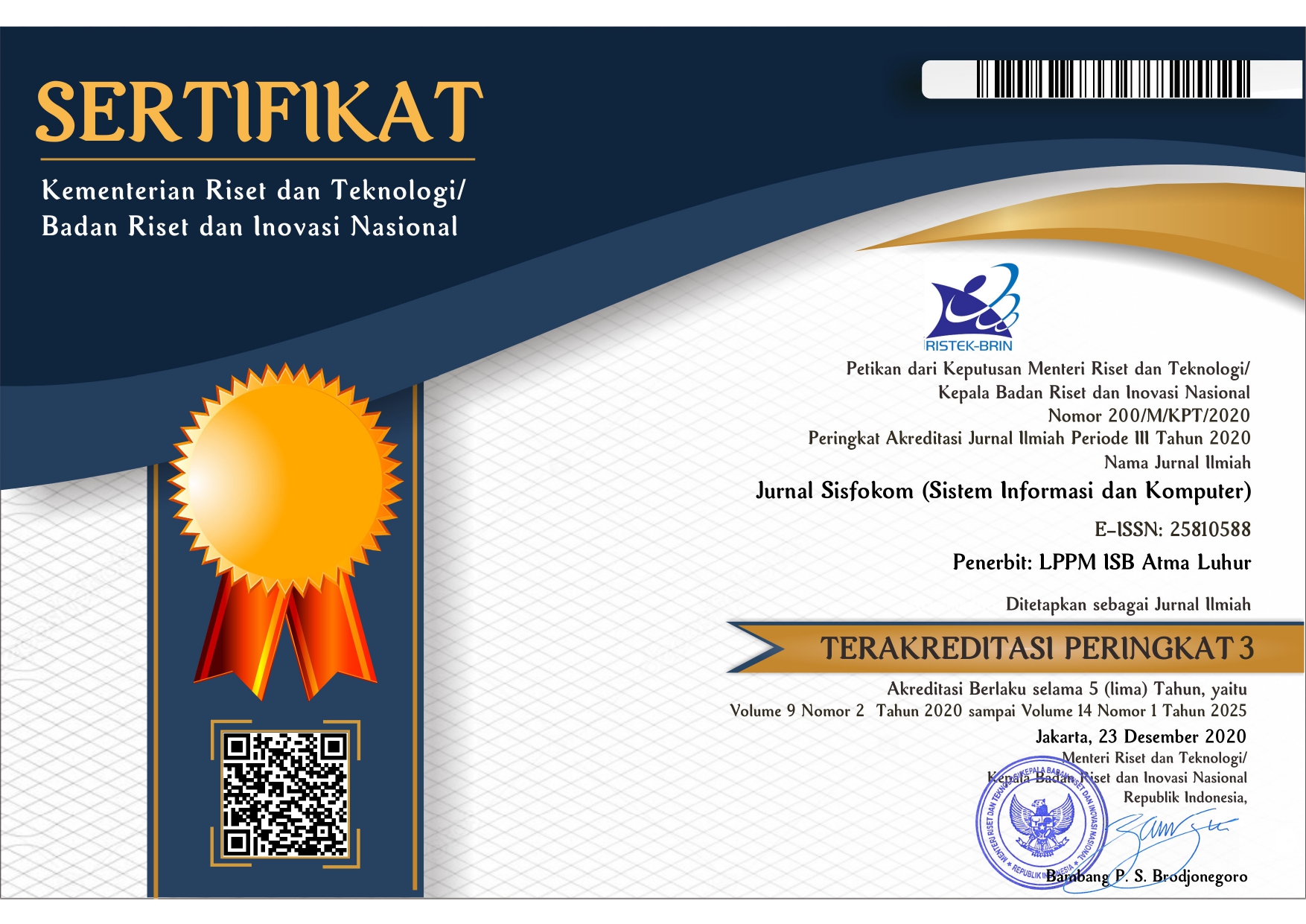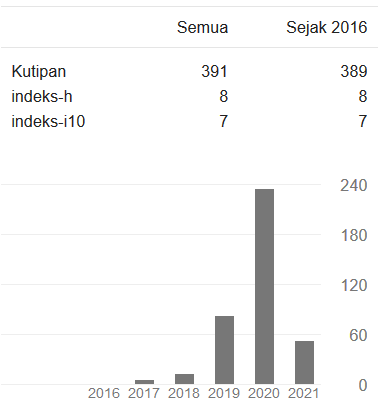Factors Influencing Acceptance of ILMU E-Learning Among Lecturers: An Empirical Study Based on UTAUT Model
DOI:
https://doi.org/10.32736/sisfokom.v13i1.1972Keywords:
E-Learning, Lecturer, User Acceptance, UTAUTAbstract
E-learning is a form of innovation in technology used in educational field, including higher education. University of Pembangunan Nasional “Veteran” Jawa Timur is one of many universities that have implemented e-learning called ILMU to support the teaching-learning process. The application of ILMU as e-learning has yet to be utilised by lecturers, due to some challenges in implementation of ILMU regarding accessibility and features of ILMU. Meanwhile, successful implementation of a technology requires acceptance from its users. This research was acquited to define what acceptance factors that influence lecturers while accessing ILMU. This study is measured using UTAUT model. The research was carried on by quantitatively distributing questionnaires to 60 lecturers. Data were analyzed and processed using SEM-PLS technique and SMARTPLS 3.0 application. Factors that influence users to receive ILMU e-learning and significantly are effort expectancy, social influence, facilitating conditions, and behavioral intention. Meanwhile, performance expectancy does not influence users significantly to accept ILMU e-learning. These factors are key indicators to of the implementation and improvement of ILMU e-learning, thus it will develop a better implementation for the lecturers to use and accept it.References
M. Maulida, E. S. Wijaya, & Misnariyani, “Penerapan Model E-Learning Readiness dan UTAUT Untuk Evaluasi Kesiapan dan Penerimaan E-Learning”, Jurnal Teknologi Informasi Universitas Lambung Mangkurat (JTIULM), vol. 6, no. 2, pp. 53 – 60, 2021.
S. K. Basak, M. Wotto, & P. Belanger, “E-learning, M-learning and D-learning: Conceptual Definition and Comparative Analysis”, E-Learning and Digital Media, vol. 15, no. 4, pp. 191 – 216, 2018. doi: 10.1177/2042753018785180
A. S. Saputra, S. S. Kusumawardani, E. Nugroho, “Pengembangan Model Awal Sistem Evaluasi Penerimaan Pengguna E-Learning Janabadra”, in Seminar Nasional Inovasi dan Aplikasi Teknologi Di Industri, Malang, 4 Februari, 2017. doi: 10.36040/seniati.v3i1.1616
M. Marsevani, “The Challenges of E-Learning for Higher Education Lecturers and Learners”, Journal of Education Technology, vol. 6, no. 3, pp. 467 – 477, 2022. doi: 10.23887/jet.v6i3.45537
E. Aboagye, J. A. Yawson, & K. N. Appiah, “COVID-19 and E-Learning: The Challenges of Students in Tertiary Institutions”, Social Education Research, vol. 2, no. 1, pp. 1 – 8, 2020. doi: 10.37256/ser.212021422
S. Khan, “A Response to “The Perspectives of Educators and Learners on E-Learning: A Cross-Sectional Descriptive Study in a Medical School [Letter]”, Advances in Medical Education and Practice, vol. 12, pp. 1293 – 1294, 2021. doi: 10.2147%2FAMEP.S344184
UPT Teknologi Informasi dan Komunikasi (TIK) UPN “Veteran” Jawa Timur, Panduan Aplikasi E-Learning Untuk Dosen, 2018. https://www.upnjatim.ac.id/download/panduan-e-learning/
I. Y. Alyoussef, “Acceptance of E-Learning in Higher Education: The Role of Task-Technology Fit with The Informasion Systems Success Model”, Heliyon, vol. 9, no. 3, 2023. doi: 10.1016/j.heliyon.2023.e13751
M. Nasir, “Evaluasi Penerimaan Teknologi Informasi Mahasiswa di Palembang Menggunakan Model UTAUT”, in Seminar Nasional Aplikasi Teknologi Informasi (SNATI), 15 Juni, 2018. https://journal.uii.ac.id/Snati/article/view/3006
M. J. Pour, M. Hosseinzadeh, M. B. Azar, F. Taheri, “Developing A New Framework For Evaluating E-Learning Systems: Integrating BSC and FAHP”, Kybernetes, vol. 46, no. 8, pp. 1303–1324, 2017. doi: https://doi.org/10.1108/K-02-2017-0060
V. Venkatesh, M. G. Morris, G. B. Davis, F. D. Davis, “User Acceptance of Information Technology: Toward a Unified View”, MIS Quarterly, vol. 27, no. 3, pp. 425–478, 2003. doi: 10.2307/30036540
I. G. A. Sukarya, I. M. A. Pradnyana, N. Sugihartini, “Analisis Faktor-Faktor yang Mempengaruhi Perilaku Penggunaan Sistem E-Learning Undiksha dengan Model Unified Theory of Acceptance and Use of Technology (UTAUT)”, INSERT: Information System and Emerging Technology Journal, vol. 1, no. 2, 2020. doi: 10.23887/insert.v1i2.25940
D. P. Karyaningtiyas, A. Yamin, K. Hermanto, “Analisis Pengaruh Minat Pemanfaatan dan Penggunaan SIAKAD sebagai Media E-learning di Universitas Teknologi Sumbawa”, Jurnal Ilmiah Ilmu Pendidikan (JIIP), vol. 5, no. 8, 2022. doi: 10.54371/jiip.v5i8.783
F. Susanto, “Metode Unified Theory of Acceptance and Use of Technology untuk Menentukan Faktor Tingkat Penerimaan Penggunaan E-Learning”, Jurnal Informatika, vol. 19, no. 2, 2019. doi: 10.30873/ji.v19i2.1779
H. Agustin, E. Mulyani, “The Acceptance and Use of E-Learning System Among Accounting Lecturers in State and Private Universities in Padang: An Empirical Study Based on UTAUT Model”, in 1st International Conferences On Economics Education, Economics, Business and Management, Accounting and Enterpreneurship (PICEEBA), vol. 37, 2018. doi: 10.2991/piceeba-18.2018.72
P. T. Aji, M. Zakarijah, Soenarto, “Faktor-Faktor Yang Mempengaruhi Penerimaan dan Penggunaan E-Learning: Studi Kasus Pembelajaran Jarak Jauh di SMK Ma’arif 1 Yogyakarta”, ELINVO (Electronics, Informatics, and Vocational Education), vol. 5, no. 2, pp. 191 – 198, 2020. doi: 10.21831/elinvo.v5i2.40699
Dr. Muh. Yani Balaka, S.E., M.Sc., Agr., Metodologi Penelitian Kuantitatif, Bandung: Widina Bhakti Persada, 2022.
Z. N. Amalia, R. W. Ulya, D. R. Hastuti, M. F. F. Mardianto, “Strutural Equation Modeling in Motivation Analysis for Milennial Participation Related to General Elections in Indonesia”, Estimasi: Journal of Statistics and Its Application, vol. 2, no. 1, 2021. doi: 10.20956/ejsa.v2i1.12479
W. W. Chin, J. –H. Cheach, Y. Liu, H. Ting, X. –J. Lim, T. H. Cham, “Demystifying the Role of Causal-Predictive Modeling Using Partial Least Squares Structural Equation Modeling in Information Systems Research”, Industrial Management & Data Systems, vol. 120, no. 12, pp. 2161-2209, 2020. doi: 10.1108/IMDS-10-2019-0529
J. F. Hair Jr, G. T. M. Hult, C. M. Ringle, M. Sarstedt, N. P Danks, S. Ray, “Partial Least Squares Structural Equation Modeling (PLS-SEM) Using R: A Workbook”, Switzerland: Springer, 2021. doi: 10.1007/978-3-030-80519-7
S. Arikunto, Prosedur Penelitian: Suatu Pendekatan Praktik, Jakarta: Rineka Cipta, 2018.
Sugiyono, Metode Penelitian Kuantitatif, Kualitatif dan R&D, Bandung: Alphabet, 2019.
U. Sekaran, R. J. Bougie, Research Methods for Business: A Skill Building Approach, 7th Edition, New York: John Wiley & Sons Inc, 2016.
J. Hair, M. Sarstedt, L. Hopkins, V. Kuppelwieser, “Partial Least Squares Structural Equation Modeling (PLS-SEM): An Emerging Tool for Business Research”, European Business Review, vol. 26, no. 2, pp. 106 – 121, 2014. doi: 10.1108/EBR-10-2013-0128
W. W. Chin, “The Partial Least Squares Approach to Structural Equation Modeling”, Modern Methods for Business Research, pp. 295 – 336, 1998.
Downloads
Published
Issue
Section
License
The copyright of the article that accepted for publication shall be assigned to Jurnal Sisfokom (Sistem Informasi dan Komputer) and LPPM ISB Atma Luhur as the publisher of the journal. Copyright includes the right to reproduce and deliver the article in all form and media, including reprints, photographs, microfilms, and any other similar reproductions, as well as translations.
Jurnal Sisfokom (Sistem Informasi dan Komputer), LPPM ISB Atma Luhur, and the Editors make every effort to ensure that no wrong or misleading data, opinions or statements be published in the journal. In any way, the contents of the articles and advertisements published in Jurnal Sisfokom (Sistem Informasi dan Komputer) are the sole and exclusive responsibility of their respective authors.
Jurnal Sisfokom (Sistem Informasi dan Komputer) has full publishing rights to the published articles. Authors are allowed to distribute articles that have been published by sharing the link or DOI of the article. Authors are allowed to use their articles for legal purposes deemed necessary without the written permission of the journal with the initial publication notification from the Jurnal Sisfokom (Sistem Informasi dan Komputer).
The Copyright Transfer Form can be downloaded [Copyright Transfer Form Jurnal Sisfokom (Sistem Informasi dan Komputer).
This agreement is to be signed by at least one of the authors who have obtained the assent of the co-author(s). After submission of this agreement signed by the corresponding author, changes of authorship or in the order of the authors listed will not be accepted. The copyright form should be signed originally, and send it to the Editorial in the form of scanned document to sisfokom@atmaluhur.ac.id.









